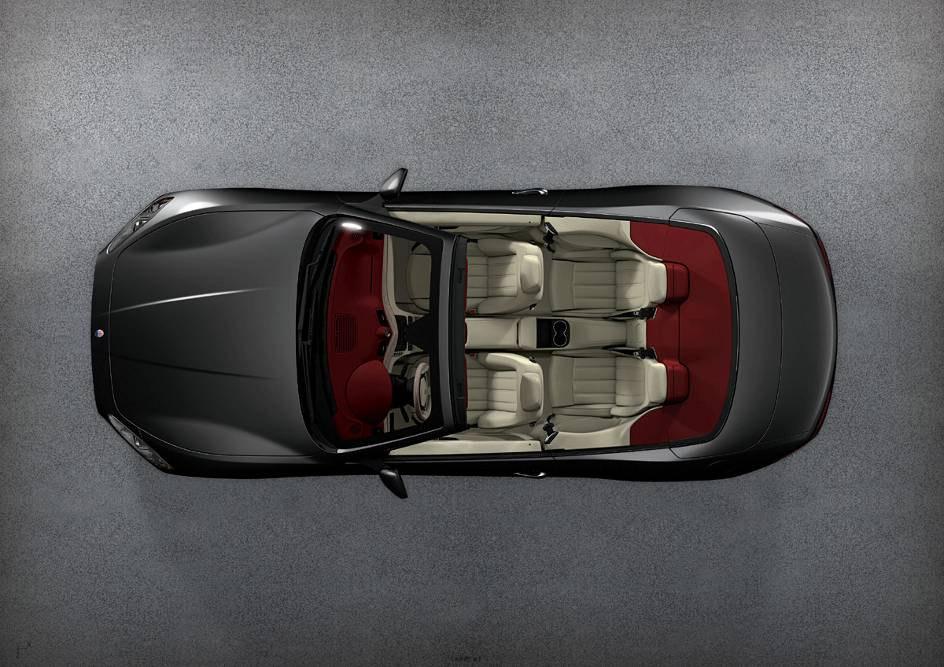
14 minute read
Maserati GranCabrio Vehicle Overview
Concept
Maserati GranCabrio: the Modenese company's first true four-seater cabriolet
Maserati GranCabrio marks a new and important chapter in Maserati’s history It is a Maserati unlike any seen before
The name, GranCabrio, evokes Maserati’s renowned traditions and experience, tying the new vehicle to the GranTurismo concept and bringing to life past GranSports. At the same time, the name underlines how much the car differs from every model that has preceded it. The GranCabrio redefines the idea of a cabriolet.
The Maserati cabrio brings the thrill and freedom of opentop motoring to four passengers enveloped in a luxurious, spacious and versatile interior It offers the chance to share a fantastic driving experience with your passengers, one enhanced by top quality materials, the aroma of prestigious woods and refined leather
The Maserati GranTurismo Cabrio represents at once the most emotional and versatile Gran Touring Cabrio on the market today It has a unique soul which clearly separates it from the other Gran Turismo models, and far removes it from its competitors.
Exterior
The Maserati GranCabrio is a dynamic and elegant cabriolet The car draws its inspiration from the GranTurismo, an example of the perfect synthesis of modernity, sensuality and passion


Created by master coachbuilder Pininfarina, the GranCabrio is characterised by its soft-top roof. This styling bonds the GranCabrio closely with the company’s refined traditions.
When closed, the rear pillar – one that does not, in fact, exist – is mimicked in the hood’s smart, forward-slanting design, giving the GranCabrio the dashing looks of a coupé
Once open, the Maserati GranCabrio transforms into an astounding cabriolet, free to show off all its sinuous, feline beauty The vibrant side-on view is accentuated by the reduced ground clearance and long bonnet. A stylish ‘V’ points towards the grille, in the middle of which is a large chrome Trident.
The flanks also feature chrome elements that give the GranCabrio some added gloss. One particularly goodlooking feature is the continuous chrome trim that encircles the cabin and integrates with the third rear stop light
Towards the back of the car, the triangular light cluster is formed by 96 LEDs with a wide diffuser that further underlines the car’s athletic poise This sporty feel is also seen in the generous 20” wheel rims that reflect the Trident design
The shape of the GranCabrio is the result of extensive aerodynamic testing aimed at limiting the drag typical of droptop cars. The GranCabrio boasts a Cx coefficient that is one of the best in its class: 0.35 with the hood up and 0.39 with it down. The spoiler and rear diffuser both contribute to obtaining top draw roadholding.
With the top extended – in other words, with the car closed – the Maserati GranCabrio presents a dynamic, modern and elegant profile The C-pillar, which is actually not present, is replaced by the eye-catching forward canted design of the top and the rear window.

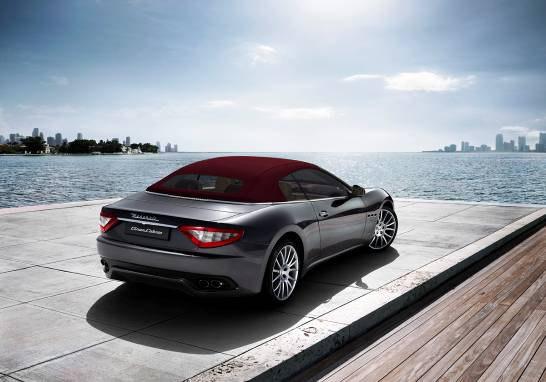

At the touch of a button the car is completely transformed – the top folds away under the tonneau cover in 28 seconds, and the inimitable character of the Maserati GranCabrio emerges.
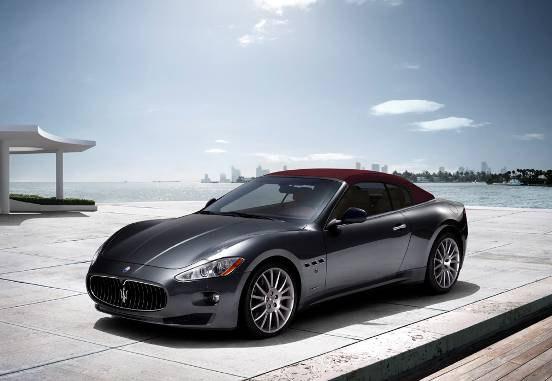
Interior
The Maserati GranCabrio's interior: roomy enough for four
The GranCabrio' s cabin offers the maximum in comfort for front and rear occupants.

The Maserati GranCabrio is the only real droptop in its class to offer enough space for four adults, seated in an elegant and luxurious cabin The space inside is much greater than the average for its category and ensures the maximum comfort even for passengers in the rear
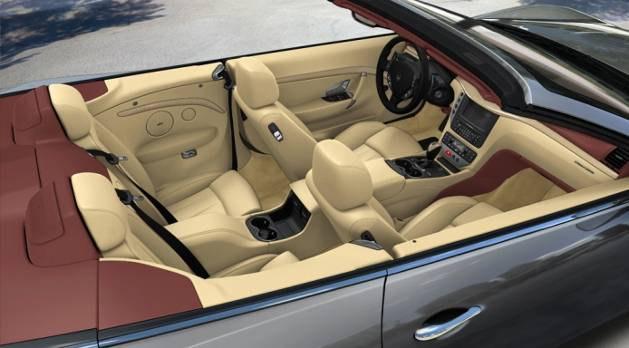
The interior is divided by a central tunnel that distributes the space between the occupants along the car’s length. The dashboard extends horizontally and its upper section features a characteristic ‘V’, a distinctive Maserati symbol.
The GranCabrio’s cabin is easy on the eye and invites you to touch it Only the finest materials were employed in its build: the leather was handcrafted by Poltrona Frau® and a selection of prestigious woods was used for the dashboard, door panel and rear flank features The level of craftsmanship and attention to detail can also be seen in the chrome rings that enhance the dashboard switches and steering wheel as well as the Alcantara finish on the back of the steering wheel paddles
Adding to the on-board comfort is the canvas hood, one made up of three layers to ensure excellent acoustic isolation. With the top down and with just two on board, it is possible to minimise interior air flow thanks to the windstop developed specially for the GranCabrio (available as an option).
On the Maserati GranCabrio, the air conditioning has been tweaked to offer the maximum comfort levels both with the top up or down The system recognises how the car is being used by automatically reprogramming the emissions mixed with air to maintain the set temperature
Technology
The GranCabrio borrows its technical underpinnings from the GranTurismo S Automatic, which was launched 6 months earlier at the Geneva Auto Show
Engine
The engine on the Maserati GranCabrio is an eight cylinder, 4691cc V90° capable of developing 440 bhp at 7000 rpm and with a peak torque of 490 Nm at 4750 rpm. The power unit uses the advanced technology typical of all Maserati engines. This allows the declared power figures to be reached, ensures smooth gear changes and a quiet engine.
The timing is actioned by two overhead camshafts per bank and four valves per cylinder controlled by hydraulic tappets The overhead camshafts on the aspirated side are controlled by a low pressure, continual timing variator, a technical solution that, together with the optimisation of the combustion chamber, allows 82% of the maximum torque from 2500 rpm for a superb overtaking, even in high gears.
Transmission
The Maserati GranCabrio features a six-speed, ZF automatic transmission with a hydraulic torque converter to give extremely fluid gear shifts while maintaining the characteristics of the sporty V8 engine

The transmission has four modes and is also fitted with self-adapting control that adjusts the type of gear change to the driving style and road conditions.
In Manual mode, gear changes are sequentially made by the driver via the steering column mounted paddles or the gearstick
Exhaust
The engine noise is emphasised by the sports exhaust managed by the by-pass valve. Pushing the Sport button opens the pneumatic valves if the car is on the move and the engine above 3000 rpm This means that the engine can be exploited to the full, giving a rewarding engine roar This becomes even more gripping with the hood down, making the car one with its surroundings
Maserati GranCabrio
Chassis
The weight distribution on the Maserati GranCabrio is slightly biased towards the rear with 49% over the front and 51% over the back with the hood up. With the hood down, the front-rear split is 48-52%.
This set up was achieved by stationing the engine behind the front axle and results in true and predictable handling that makes driving easier and renders the car more stable
The new loadbearing chassis is constructed from a blend of materials with an eye on keeping the weight down. The framework is made from toughened steel apart from the bonnet and front crash protection bar, in aluminium, and the boot lid in heat treated plastic that uses Sheet Moulding Compound technology. The chassis was developed to provide maximum stiffness even without a roof The result is that the Maserati GranCabrio is able to offer the same driving pleasure as any quality closed-top cars
Suspension
The Maserati GranCabrio is fitted with the electronically controlled Skyhook suspension as standard. This system employs dampers with an aluminium body that continually adjust the damping. This solution means that the set up adapts instantly to the driving style and the road conditions to offer the utmost in on-board comfort.
The Skyhook system acts by using acceleration sensors that detect movement on all four wheels and the body A control unit processes the data it receives from the sensors, analyses the driving style and road surface and instantly adjusts the dampers accordingly via their proportional valves
Electronics
The car’s already superb dynamic handling is constantly monitored and optimised by the Maserati Stability Programme (MSP) The MSP kicks in to correct even the hint of a skid by reducing torque Working with the ABS and EBD, the system stops the wheels locking under braking and distributes the braking between the front and rear axles It also prevents the wheels spinning on low grip surfaces when accelerating or downshifting (ASR and MSR)
Hood
The Maserati GranCabrio’s canvas hood was a technological as well as aesthetic choice The soft top solution means a lower centre of gravity because the bottom of the car is heavier This enhances the car’s dynamic handling
The hood weighs only 65kg and the materials, mechanism, its operation time and stowage are all top quality. The GranCabrio transforms from a splendid coupé into a cabriolet in just 28 seconds even if the car is travelling up to 30 km/h.
Maserati GranCabrio
Safety
The Maserati GranCabrio is on a par with the highest safety standards in its category thanks to the adoption of innovative active and passive safety features.
Active safety
The dynamic handling on the GranCabrio is assisted by the electronically controlled Maserati Stability Programme (MSP). The technology was developed to optimise the driving dynamics and safety when on the move.
The high performance brakes on the GranCabrio were built by Brembo and feature four self-ventilating drilled discs The 360 mm front brakes make the most of dual-cast disc technology (cast iron for the braking surface and an aluminium hat) This solution, teamed with callipers actioned by six pistons in a single aluminium block, ensure unbeatable stopping power and are highly resistant to fade even under intense use MSP works in harmony with the ABS to stop the wheels locking under braking, and EBD, to distribute the braking force between the front and rear axles
The Electric Park Brake (EPB) replaces the traditional mechanical handbrake with an electronic control on the central tunnel. The EPB system is engaged automatically when the engine is switched off and is deactivated when the accelerator pedal is pressed. EPB also plays an important role in terms of safety as, in an emergency, it acts on all four wheels and can be employed with the vehicle in movement, without compromising stability, until the switch is released
The Hydraulic Brake Assist (HBA) has been introduced on the Maserati GranCabrio to improve safety Thanks to a dedicated sensor, HBA recognises panic braking by measuring the speed at which the brake pedal is depressed and clamps the brake pads to the disc with greater force than the driver develops during braking. This shortens the stopping distance in emergency situations.
Passive safety
The Maserati GranCabrio is fitted with new generation airbags, using the intelligent technology first employed on the Maserati Quattroporte S The passenger side airbag, with its ‘Low Risk Deployment’, adapts the intensity of its inflation in crash situations to the size of the occupant
New head and chest airbags set in the front seats provide protection from side impacts while seatbelts are equipped with the latest pre-tensioners and load limiters to securely contain the occupants.
The main introduction in terms of passive safety is the extendable roll bars set behind the rear seats The roll bars are hidden by the hood cover and are activated in just 190 milliseconds when needed
The extendable roll bars were developed to offer occupants the maximum protection both with the hood raised or tucked away. A Maserati copyrighted technical solution allows the roll bars to extend by shattering the rear window without any risk for the occupants.
Personalisation
Discover the personalisation options on the Maserati GranCabrio
The GranCabrio introduces new personalisation options to the Maserati range
Maserati offers a personalisation programme that is unlike any other in the world. This programme has been developed with the objective of allowing each client to create a made-to-measure car. Such a level of exclusivity is a source of pride for Maserati, a small company able to devote the highest levels of care and attention to every car it builds and guarantee the client a wider range of finishes than its competitors.
The personalisation options on the GranCabrio have been enhanced by the soft top hood, available in six colours, and by the introduction of two new Poltrona Frau® tints, Bianco Polare and Blu Profondità The colours are available on the Maserati range for the first time and were developed for their harmony with the exterior colours and hood
The dashboard, door panels and rear side panels are available in the new ‘Dark Chrome’ standard colour but it is also possible to choose from various lacquer finishes or precious woods, among them Carbalho and Moonwood.
In terms of the mechanics, there are two colours for the wheel rims (Silver or Grigio Mercury) and six colours for the brake calipers
The Car Configurator
Maserati provides excellent support in configuring even the smallest details on the GranCabrio. The Car Configurator gives the client the opportunity to create his ideal car online and ensure that the combination he has chosen, including the colour of the leather and materials, the finish of the headlining, the stitching and the carpets, is really what he wants
Atelier Maserati
Visitors to the Modena headquarters can make the most of expert help in creating their dream car by using the Atelier Maserati, just like they would for a suit styled by a master tailor
The Atelier provides examples of the available options for the interior thanks to a special table showing colour samples of the leathers, the carpets, the stitching and the finishes Clients can also browse colours for the interior and exterior and feel for themselves how the different materials combine with one another, allowing them to check the options selected on the Car Configurator.
GranCabrio Predecessors
GranCabrio Predecessors
Maserati has a long and impressive heritage of constructing open-top motor cars. The following pages offer a brief overview of Maserati’s most distinct open top Gran Turismo models from the very beginning till today


Years of production: 1950-1951
Numbers produced: 16 Engine: 6 cylinder, 2000cc, 100 hp
The A6G or 2000 Gran Turismo had a new two-litre engine based on the power unit of the A6GCS racing cars. Compression ratio and thus power was reduced to allow the engine to run on commercial fuel, of which excellent quality was not always guaranteed. Coupé bodies ware built by Frua, Vignale and Pinin Farina and an elegant spyder version was created by Frua. All bodies were of great luxury, refined and cured in every detail However a high list price and performances not matching the quickly changing standard in the luxury car segment didn’t favour its sales Only 16 vehicles were produced
3500 GT & GTI Vignale Spyder
GranCabrio Predecessors
Years of production: 1958-1964
Numbers produced: 242
Engine: 6 cylinder, 3.5L, 220 & 235 hp
Almost simultaneously with the coupé, an open version of the 3500 GT was under development. Early prototypes of the Spyder were made by Touring and Frua, but the final design was a masterpiece of designer Giovanni Michelotti when he was working for Vignale. The body was now made from steel instead of aluminium and was fitted on a 10 cm shortened chassis. Also the Spyder adopted the Lucas fuel injection system and its drum brakes were replaced by more modern disc brakes on later versions, although drum brakes remained available upon request.
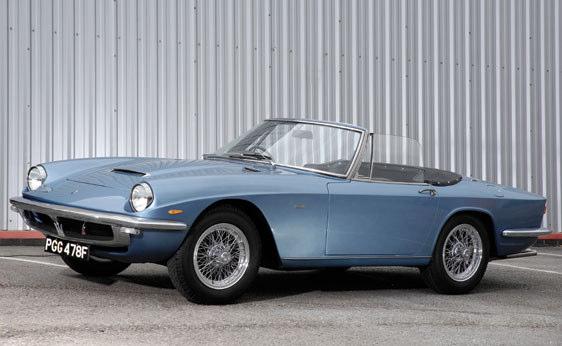

Mistral Spyder
Years of production: 1964-1969
Numbers produced: about 120
Engine: 6 cylinder; 3 5L, 3,7L & 4 0L; 220-265 hp
The Mistral initiated Maserati’s tradition to name its Gran Turismo cars after famous winds (the Ghibli, Bora, Merak, Khamsin, Karif and Shamal would follow) The Mistral shared its mechanical base with the Sebring but, thanks to its 2-seater fastback body from Pietro Frua, had a much more modern appearance compared to the more traditional styled 2+2 Sebring A first prototype of the Mistral was presented at the Turin motorshow in the autumn of 1963 but production didn’t start before 1964 The body was from steel but the doors, bonnet and rear window frame were made from aluminium to reduce the weight. An open Spyder version was presented at the Geneva motorshow in March 1964. The Spyder was produced in about 120 units.
Maserati GranCabrio
Ghibli Spyder
GranCabrio Predecessors
Years of production: 1967-1972
Numbers produced: 125
Engine: 90°V8, 4.7L & 4.9L, 340 & 330 hp
In 1966 a project was started for a new sporty Gran Turismo in the best tradition of the Maserati Brand. The new Ghibli, named after a desert breeze, was strictly a 2-seater and its beautiful design was a true masterpiece of the young designer Giorgetto Giugiaro during his period at Ghia. The body of the Ghibli was perfect in every detail and is still regarded as one of Giugiaro’s most beautiful designs. The V8 engine from the Quattroporte/Mexico adopted a dry sump lubrication system in order to fit under the long and low Ghibli bonnet. From 1969 the Ghibli was also made available with a 4.9L engine, named Ghibli SS, and an open Spyder version was added, of which only 125 units were produced
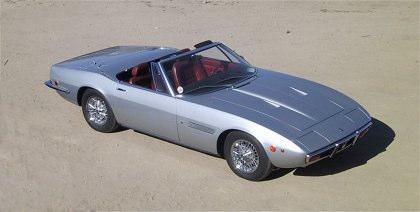
Biturbo Spyder
Years of production: 1985-1994
Numbers produced: 3076 (all versions)
Engine: 90°V6 twin turbo 18v; 2 0L, 2 5L & 2 8L; 180-224 hp; 90°V6 twin turbo 24v, 2.0L, 241 hp
Top performances and open top driving fun were again combined in the Biturbo Spyder who was the first open Maserati since the Ghibli Spyder, more than 12 years earlier Development for the body was done by Zagato near Milan while the bodies were assembled in Turin before transportation to Modena where the mechanical parts were added. The 2514 mm wheelbase from the Biturbo was reduced to 2400 mm for the Spyder models. The Biturbo Spyder existed in various versions and followed the same technical and aesthetical evolutions as the coupe, with exception of the 24-valve 2.8L engine. The various versions were: Biturbo Spyder, Biturbo Spyder 2500, Biturbo Spyder i, Biturbo Spyder i 2500, Biturbo Spyder 2 8i, Spyder 2 0 4v and Spyder 2 8 In 1991 the Biturbo name was dropped for the open models

Spyder GT & Spyder Cambiocorsa
GranCabrio Predecessors
Years of production: 2001-2007
Numbers produced: 3889
Engine: 90°V8 dry sump, 4 2L, 390 hp
With the introduction of the Maserati Spyder, at the Frankfurt motor show of 2001, again a new area started for Maserati, this time an area of close technical collaboration with group partner Ferrari. Whilst the exterior of the new Spyder still bore strong resemblance to the 3200GT model, under the skin this car was completely new. Under the hood the twin-turbo unit had been dropped in favour of a completely new, normallyaspirated 4.2L V8 with a dry sump lubrication system. Also the transmission was totally new. The gearbox is moved to the rear end of the car where it forms a single unit with the differential (transaxle). The Spyder has a shortened wheelbase with respect to the Coupé and is strictly a two-seater only. The soft-top opens and closes fully automatically. This model initiated the return of the Maserati brand to the United States
GranSport Spyder
Years of production: 2005-2007
Numbers produced: 472
Engine: 90°V8 dry sump, 4.2L, 400 hp
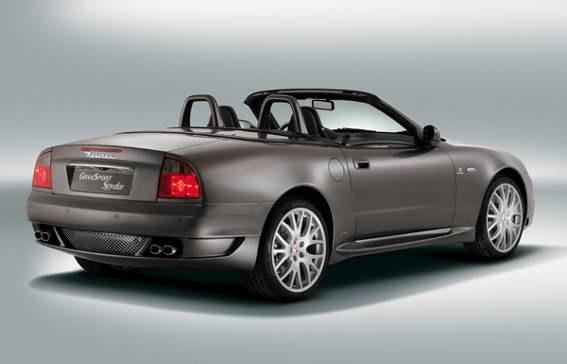
With the GranSport Spyder, presented at the Frankfurt motor show of 2005, also enthusiasts of open top motoring could now enjoy the enhanced performance and the more agressive character of the GranSport Thanks to its shorter wheelbase, the GranSport Spyder is even more agile than its coupé sister model. The modifications with respect to the normal Spyder model are in-line with those of the coupé version of the GranSport: increased engine power up to 400 hp; improved control logic of the Cambiocorsa gearbox (now standard); new 19-inch alloy wheels; upgraded suspensions; a new front bumper with larger grille; aerodynamic side sills and a more sporty interior with new seats.

Maserati GranCabrio
0. General Information
Model code: M145 BD
Engine code: F136YI
Location of production: Modena, Italy
Start of production: January 2010
General Information
Start of sales: from March 2010 (depending on the market)
Location of VIN and identification plates
A Manufacturer logo
B. Homologation number
C VIN
D Maximum load
E Maximum load on front axle
F. Maximum load on rear axle
G Engine type
H Vehicle version code
L Assembly number








